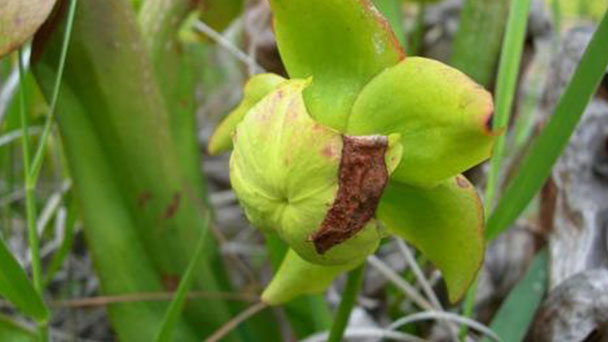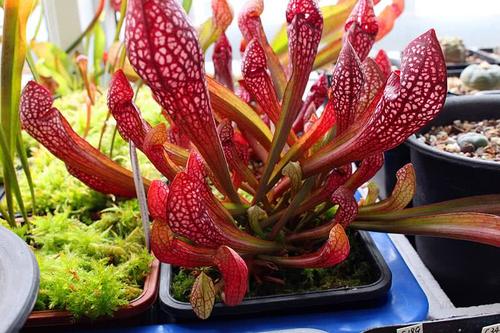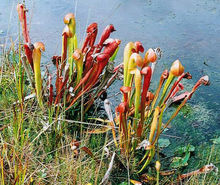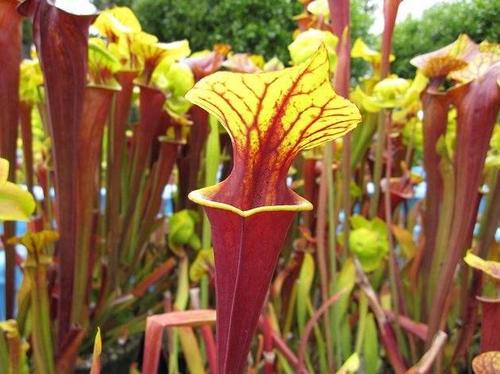Sarracenia minor (hooded pitcher plant) profile
Written by Maggie
Mar 26 2021

Sarracenia minor (also called: hooded pitcher plant) leaves are basal, long tubular, up to 70cm long, narrowly winged at the border, green; The lid is ovate downward curved, leaving only a narrow opening, often dark red, inflorescences from the leaf base, height is shorter than the leaf, yellow-green flowers, no fragrance; It is similar in shape to the cage of the pitcher plant and can secrete honey and digestive juice. Insects attracted by the honey slip into the bottle and the digestive juice inside the bottle will digest the insects. Easily planted, insectivorous and water-loving, Sarracenia minor grows well in full sun, making it ideal for planting. Sarracenia minor is native to North America, Carolina and Florida, USA.
Sarracenia minor picture

Sarracenia minor info
| Botanical Name | Sarracenia minor |
| Common Names | hooded pitcher plant |
| Plant Type | Herbaceous perennial |
| Sun | Full sun |
| Hardiness Zones | 6 to 8 |
| Flower color | Yellow |
| Native Area | North Carolina to Florida |
| Mature size | 0.75 to 1.50 feet tall, 1.00 to 2.00 feet wide |
Morphological characteristics of Sarracenia minor
Sarracenia minor is a perennial herb with creeping rhizomes and many fibrous roots; Leaf base generated rosette leaves, by leaves, cylindrical or tubular upright, pitcher one insect capsule, capsule wall opening is smooth, and gave birth to a nectary, sweet honey, come to lure insects and fall into a bag, the capsule wall is smooth, it contains digestive juices, can secrete digestive enzymes to insects decomposition, and then by internal glands of parenchyma cells into protein enzymes to absorb; In addition, sarracenia minor grows sword-shaped leaves in the fall and winter, which have no traps and are used only by photosynthesis to produce nutrients.
Each leaf is curved at right angles and has a hood like a bonnet. It is bright in color, with gorgeous spots and shapes similar to the cage of the Sarracenia minor. The plants are bright red and purple in color. The nectar glands inside the leaf cover provide some nectar food for the insects. Sarracenia minor's bottle stems are long and narrow, allowing the insects that fall into the capsule to slide further, and the insects are unable to fly out of the narrow tube. The bottle stems and leaves digest the soft parts of the insect, but the hard shell parts remain.
The flower of Sarracenia minor is bisexual, the inflorescence is drawn from the base of leaves, is lose raceme, consists of several large flowers in total, the flower core consists of a helmet-shaped stigma, 3 to 5 locules ovary and 50 to 80 stamens, yellow-green flowers, calyx 5 pieces, located at the bottom of the petals. The fruit is a capsule containing a large number of tiny seeds that automatically dehisces and ejects the seeds when ripe. The flowers of Sarracenia minor open downward and have round yellow petals covered with small white spots. These characteristics are used to identify the species and distinguish it from other pitcher plants. Seeds are saccate, ca. 3 mm long, scabrous, surface knobbly.
Ecological habits of Sarracenia Minor
Sarracenia minor is native to the East Coast of the United States, along with swampy areas and pine forests.
The distribution of Sarracenia minor
Sarracenia minor distributes in North Carolina, South Carolina, Georgia and Florida.
Propagation of Sarracenia minor
Division
Sarracenia minor grows side buds and, when large enough, are separated from the mother plant and grown separately.
Cuttings
Using leaf cuttings or rhizome cuttings to propagate Sarracenia minor, and we can cut the leaf and a half off from the mother, oblique inserted on the clean substrate, or will be cut into 2.5 cm a rhizome, incision daub fungicide, flat on a clean substrate, again above water wet moss on the shop, keep high humidity and bright light, about 2 months or so can sprout.
Sow
Sarracenia minor seeds have a longer shelf life, up to 3-5 years, but also a longer germinating time, 2 to 4 months. Before sowing, low-temperature refrigeration (about 5 degrees) for 1-2 months, and keep the seeds wet, can be wrapped in wet napkins or put in wet water moss, in order to avoid mildew, water moss and seeds had better be disinfected, and regularly check (also can not be refrigerated directly in winter, or spring low-temperature sowing); Refrigerated after planting suitable temperature for 15 to 30 degrees, seed directly to clean the surface of the substrate, and the surface does not cover the soil or cover 1-3 mm tall fine peat or fine jade red soil fixed root, in order to help maintain high humidity and bright light, a month or so of germination (also has a few months or even a year after germination), kind of 3 to 5 years to grow to be into a plant.

How to grow and care for Sarracenia minor
Sarracenia minor grows in open swamps, like sufficient light, moist soil, and are not afraid of cold and low air humidity. It is an insectivorous plant that is easy to grow.
Substrate
In the growing season, Sarracenia minor is more suitable to be grown by the pot leaching method, which can use a mixture of 1 part peat and 1 part perlite or coarse sand. The dormant period needs to be removed from the water tray, to keep the dry state, to prevent root rot. A mixture of pure water moss, 2 parts peat and 1 part perlite or coarse sand can also be used.
Moisture
Use water with a low mineral concentration, and plant in a pot during the growing season to keep the substrate high humidity.
Humidity
Sarracenia minor air humidity requirements are not high, as long as the above 30% can be maintained.
Temperature
The suitable temperature for growth is 20-30 ° C, and it will hibernate below 10 ° C and can survive at 0-38 ° C.
Light
Sarracenia minor is a light-loving plant, and can accept full sunshine, and the light can make the plant bright color, but in summer to avoid high temperature, can be an appropriate shade.
Nutrients
During the growing season, use a four-thousandfold dilution of all-purpose compound fertilizer and spray on the foliage or fill the bottle 1/3 of the height once or twice a month.
The use of Sarracenia Minor
Sarracenia minor does not come cheap on the Chinese market, with a single seedling selling for 180 yuan.

Latest Updated
- Benefits of Bugleweed - 7 Science-backed Health Benefits
- Bugleweed Dangers & Side Effects - Is It Poisonous?
- How to Plant Evergreen Trees - What You Should Know
- When to Plant Evergreens - Grow Guide for Evergreen Trees
- 12 Wonderful Evergreen Shrubs for Your Garden
- 12 Popular Evergreen Plants with Pictures for Beginners
- When And How To Prune A Lilac Bush Like a Pro
- How to Grow & Care for Lilac Vine (Hardenbergia Violacea)
- Japanese Lilac Tree (Syringa Reticulata) Care & Propagation Guide
- Shumard Oak Pros and Cons - What to Know
Popular Articles
- Winter maintenance of Antirrhinum Majus
- How to Grow Terminalia Mantaly Tree
- How to Grow and Care for Crossostephium Chinense
- How to grow Antirrhinum Majus in spring
- Peristeria Elata (Dove Orchid) Profile: Info & Care Guide
- Underwatered Snake Plant (Sansevieria Trifasciata) - Signs And How To Fix
- How to Care for Brazilian Jasmine Plant (Mandevilla Sanderi)
- How to Grow & Care for Graptopetalum Purple Delight in Summer
- Rosa Chinensis (China Rose): Plant Growing & Care Tips
- How to Care for Baby Sun Rose (Aptenia Cordifolia)